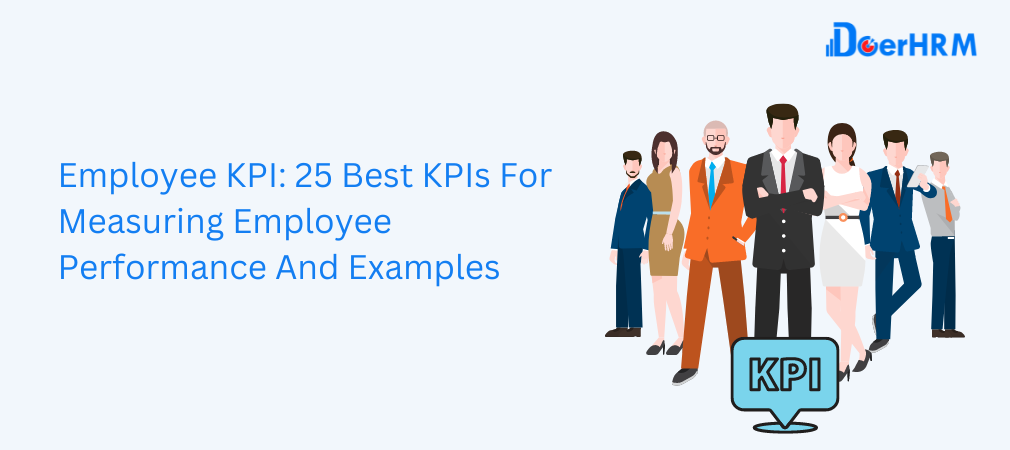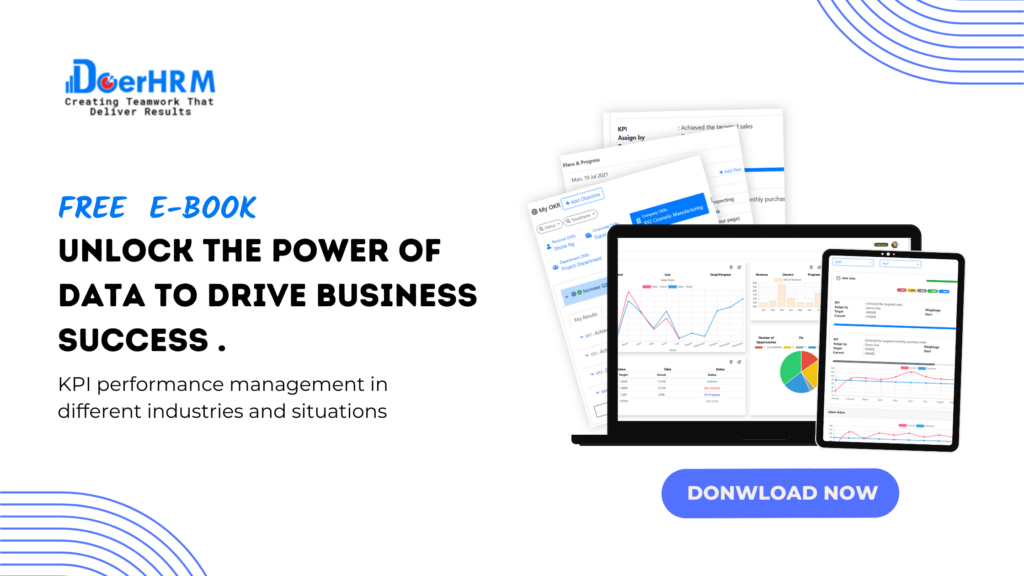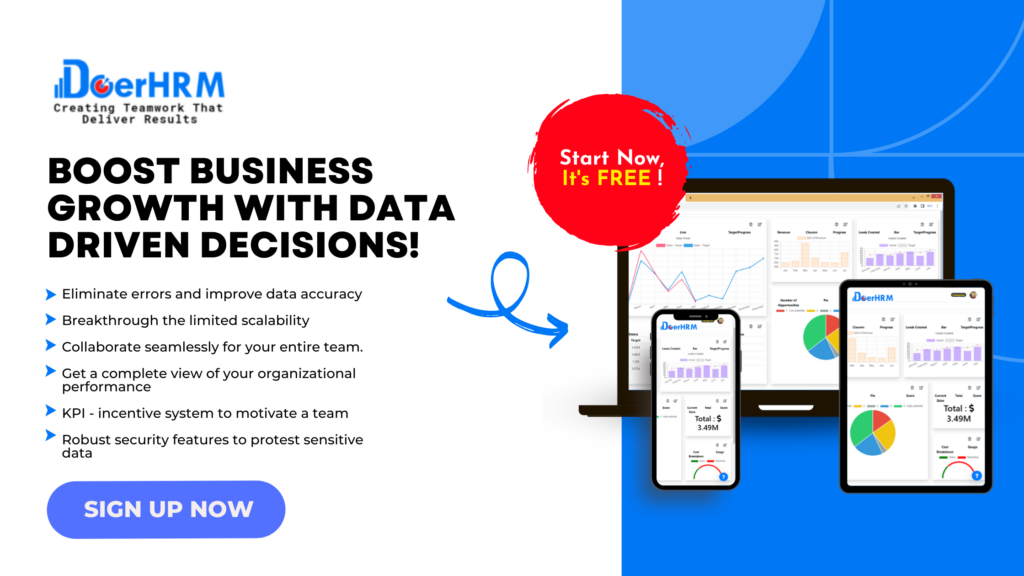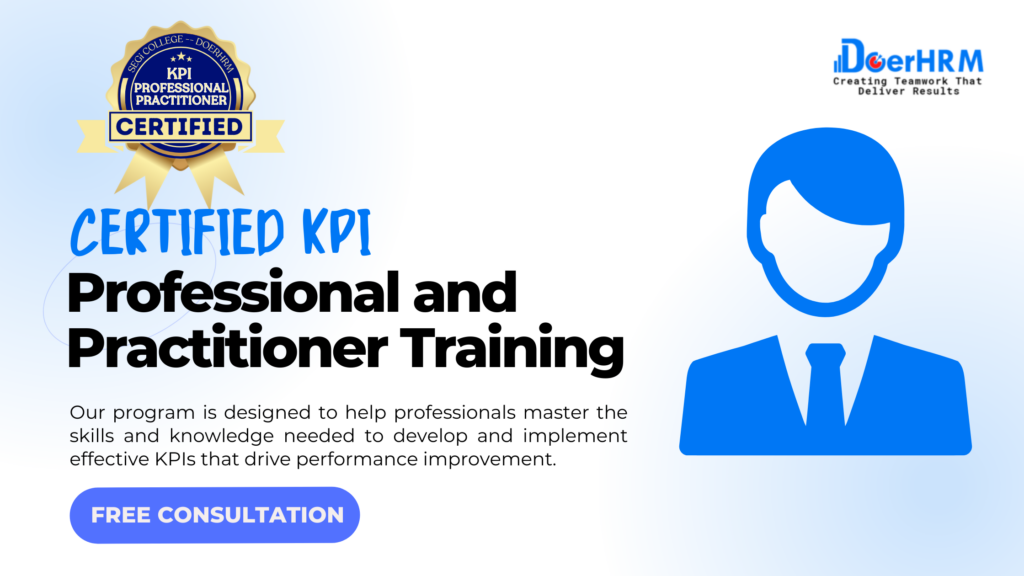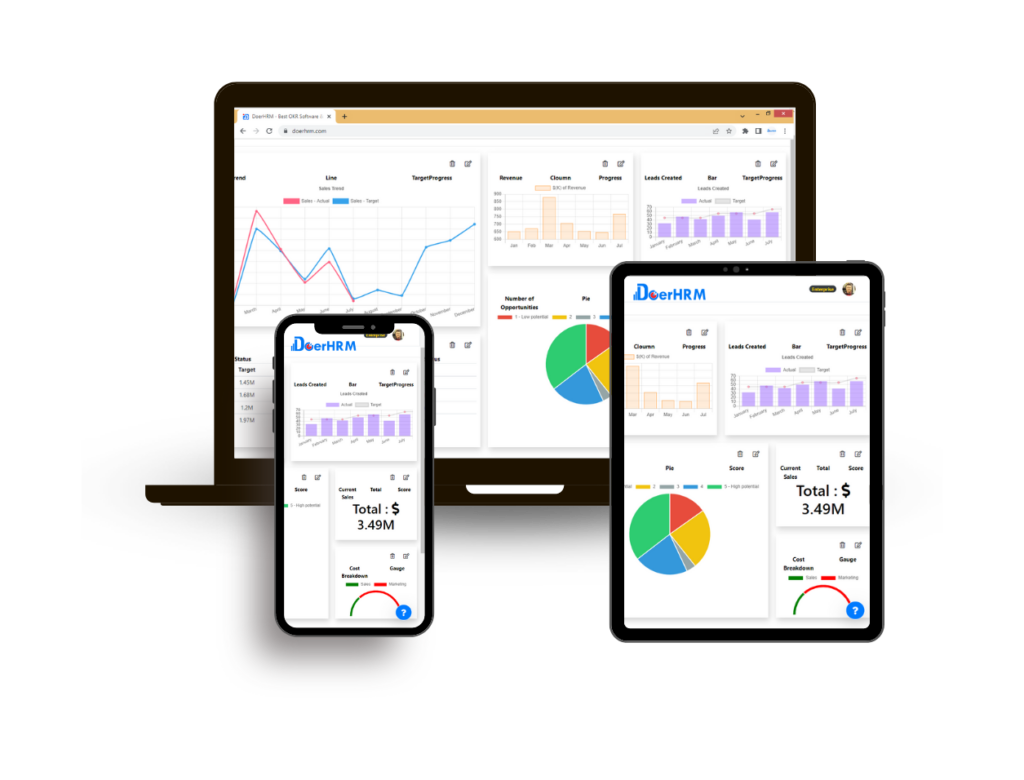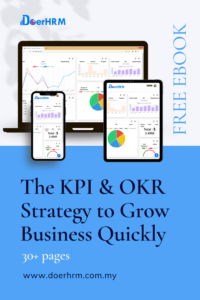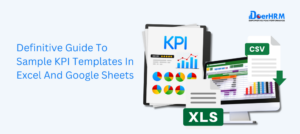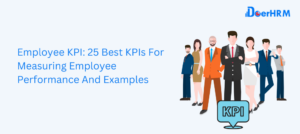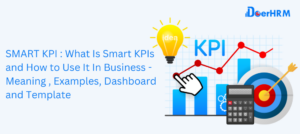Employee KPI are metrics that help businesses track the performance of their employees in order to achieve specific goals and objectives. KPIs are a valuable tool for companies to monitor and evaluate the progress of their employees and teams, and to identify areas where improvements can be made.
Setting Employee KPIs is crucial for businesses that want to stay competitive and achieve their desired outcomes. By setting specific, measurable, achievable, relevant, and time-bound KPIs for their employees, businesses can align individual performance with organizational objectives and monitor progress towards achieving those objectives.
There are many Employee KPIs that businesses can use to measure performance, and each KPI serves a specific purpose. In this article, we will provide a brief overview of the 25 best KPIs for measuring employee performance across various categories, including sales, productivity, financial, customer, and employee metrics. By understanding these KPIs, businesses can choose the most appropriate metrics for their goals and objectives, and track their employees’ progress accordingly.
Table of Contents
The 25 Best Employee KPI
A. Sales Metrics
1. Sales growth rate - Employee KPI
Sales growth rate is a KPI that measures the percentage increase or decrease in a company’s sales revenue over a specific period of time, typically annually or quarterly. This KPI is a valuable indicator of a company’s sales performance and its ability to generate revenue.
To calculate sales growth rate, businesses can use the following formula:
((Current period sales revenue – Previous period sales revenue) / Previous period sales revenue) x 100
For example, if a company had $1 million in sales revenue last year and $1.2 million in sales revenue this year, the sales growth rate would be:
(($1.2 million – $1 million) / $1 million) x 100 = 20%
A high sales growth rate indicates that a company is successfully increasing its sales revenue and expanding its customer base. This KPI can help businesses identify areas where they need to focus their sales efforts and make necessary changes to their sales strategy.
On the other hand, a low sales growth rate could indicate a decline in sales performance or increased competition. By tracking sales growth rate over time, businesses can identify trends and adjust their sales strategy accordingly to maintain or improve their sales revenue.
2. Average revenue per sale - Employee KPI
Average revenue per sale is a KPI that measures the average amount of revenue generated by a single sale. This KPI is a useful tool for businesses to evaluate the effectiveness of their sales strategy and identify areas where improvements can be made.
To calculate average revenue per sale, businesses can use the following formula:
Total revenue / Total number of sales
For example, if a company had $1 million in revenue from 1,000 sales, the average revenue per sale would be:
$1 million / 1,000 sales = $1,000 per sale
A high average revenue per sale indicates that a company is effectively upselling or cross-selling to its customers, or selling higher-priced products or services. This KPI can help businesses identify their most valuable customers and tailor their sales strategy to maximize revenue.
On the other hand, a low average revenue per sale could indicate that a company is not effectively capitalizing on sales opportunities or that their products or services are priced too low. By tracking average revenue per sale over time, businesses can identify trends and make adjustments to their sales strategy to improve revenue and profitability.
3. Conversion rate - Employee KPI
Conversion rate is a KPI that measures the percentage of potential customers who take a desired action, such as making a purchase or filling out a form, out of the total number of potential customers who interact with a company’s sales or marketing materials. This KPI is a valuable indicator of a company’s sales and marketing performance and can help businesses identify areas where they need to improve their strategy to increase their conversion rates.
To calculate conversion rate, businesses can use the following formula:
(Number of conversions / Total number of interactions) x 100
For example, if a company had 100 website visitors and 10 of them made a purchase, the conversion rate would be:
(10 / 100) x 100 = 10%
A high conversion rate indicates that a company’s sales or marketing strategy is effective at persuading potential customers to take the desired action. This KPI can help businesses identify which sales or marketing channels are most effective at converting potential customers into actual customers.
On the other hand, a low conversion rate could indicate that a company’s sales or marketing strategy is not effectively engaging potential customers or that there are issues with the sales process, such as a difficult checkout process or poor customer service. By tracking conversion rate over time, businesses can identify trends and adjust their sales and marketing strategy accordingly to improve their conversion rates.
4. Sales per employee - Employee KPI
Sales per employee is a KPI that measures the amount of revenue generated by each employee of a company. This KPI is a useful tool for businesses to evaluate the effectiveness of their sales team and identify areas where improvements can be made.
To calculate sales per employee, businesses can use the following formula:
Total sales revenue / Total number of employees
For example, if a company had $10 million in sales revenue and 100 employees, the sales per employee would be:
$10 million / 100 employees = $100,000 per employee
A high sales per employee ratio indicates that a company is effectively utilizing its workforce to generate revenue. This KPI can help businesses identify their top-performing sales employees and reward them accordingly, as well as identify areas where additional sales training or resources may be necessary.
On the other hand, a low sales per employee ratio could indicate that a company is not effectively utilizing its workforce or that there are issues with the sales process, such as ineffective sales training or a lack of resources. By tracking sales per employee over time, businesses can identify trends and make adjustments to their sales strategy to improve revenue and profitability.
5. Customer lifetime value - Employee KPI
Customer lifetime value (CLV) is a KPI that measures the total amount of revenue a customer is expected to generate for a business over the course of their relationship with the company. This KPI is an important metric for businesses to understand, as it can help them identify their most valuable customers and tailor their sales and marketing strategies accordingly.
To calculate CLV, businesses can use the following formula:
(Average value of a sale) x (Number of repeat transactions) x (Average customer lifespan)
For example, if a company has an average sale value of $50, and their customers make an average of 3 purchases per year, with an average lifespan of 5 years, the CLV would be:
$50 x 3 x 5 = $750
A high CLV indicates that a customer is likely to generate a significant amount of revenue for a business over their lifetime, making them a valuable asset to the company. This KPI can help businesses identify their most valuable customers and tailor their sales and marketing strategies to retain these customers and encourage them to make additional purchases.
On the other hand, a low CLV could indicate that a company’s sales and marketing strategies are not effectively engaging customers or that there are issues with the product or service being offered. By tracking CLV over time, businesses can identify trends and make adjustments to their sales and marketing strategies to increase customer retention and maximize revenue.
Related article : Sales KPI: 28 Metrics For Sales Manager – Examples, Meaning, Template, Dashboard
B. Productivity Metrics
6. Time to complete a task - Employee KPI
Time to complete a task is a KPI that measures how long it takes an employee to complete a specific task or project. This KPI is useful for businesses to understand how efficiently their employees are working and to identify areas where improvements can be made to increase productivity.
To measure time to complete a task, businesses can track the amount of time it takes employees to complete specific tasks or projects and compare this data to established benchmarks or industry standards. This KPI can help businesses identify their most productive employees and tailor their training and development programs to improve the productivity of their workforce.
A high time to complete a task can indicate that an employee is struggling with the task or project, or that there are inefficiencies in the process that are slowing down productivity. By identifying the root cause of the issue, businesses can make changes to the process or provide additional support to employees to help them complete tasks more efficiently.
On the other hand, a low time to complete a task can indicate that an employee is rushing through the task or project, potentially sacrificing quality for speed. Businesses should be careful not to prioritize speed over quality, as this can lead to mistakes and ultimately harm the business.
7. Number of tasks completed per day - Employee KPI
The number of tasks completed per day is a KPI that measures how many tasks or projects an employee completes in a given workday. This KPI is useful for businesses to understand how efficiently their employees are working and to identify areas where improvements can be made to increase productivity.
To measure the number of tasks completed per day, businesses can track the number of tasks completed by each employee in a given workday and compare this data to established benchmarks or industry standards. This KPI can help businesses identify their most productive employees and tailor their training and development programs to improve the productivity of their workforce.
A high number of tasks completed per day can indicate that an employee is efficient and productive, completing their work quickly and effectively. However, it is important to note that the quality of work should not be sacrificed in the pursuit of completing more tasks. Businesses should also consider the complexity of the tasks being completed and adjust benchmarks accordingly.
On the other hand, a low number of tasks completed per day can indicate that an employee is struggling to keep up with their workload or that there are inefficiencies in the process that are slowing down productivity. By identifying the root cause of the issue, businesses can make changes to the process or provide additional support to employees to help them complete tasks more efficiently.
8. Error rate - Employee KPI
Error rate is a KPI that measures the number of mistakes or errors made by an employee during a specific time period. This KPI is useful for businesses to understand the quality of work being produced by their employees and to identify areas where improvements can be made to increase efficiency and reduce costs.
To measure error rate, businesses can track the number of errors made by an employee in a specific time period and compare this data to established benchmarks or industry standards. This KPI can help businesses identify their most effective employees and tailor their training and development programs to improve the quality of their work.
A high error rate can indicate that an employee is struggling to complete their work accurately or that there are inefficiencies in the process that are causing errors. By identifying the root cause of the issue, businesses can make changes to the process or provide additional support to employees to help them complete tasks more accurately.
On the other hand, a low error rate can indicate that an employee is completing their work accurately and effectively. However, it is important to note that a low error rate does not necessarily mean that an employee is productive or efficient, as they may be taking an excessive amount of time to complete their work.
9. Attendance and punctuality - Employee KPI
Attendance and punctuality is a KPI that measures an employee’s reliability in attending work and being punctual. This KPI is important for businesses to monitor as it can impact the overall productivity and efficiency of the workforce.
To measure attendance and punctuality, businesses can track the number of times an employee is absent or late to work and compare this data to established benchmarks or industry standards. This KPI can help businesses identify any patterns or trends in absenteeism or tardiness and take appropriate action to address the issue.
A high level of attendance and punctuality indicates that an employee is reliable and committed to their work. This can improve the overall morale of the workplace and lead to increased productivity and efficiency. On the other hand, a low level of attendance and punctuality can negatively impact the productivity and efficiency of the workplace and create additional work for other employees who must cover for the absent or tardy employee.
In addition to impacting productivity, attendance and punctuality can also impact customer satisfaction. If an employee is consistently absent or tardy, this can lead to delays in completing work or providing services to customers. This can result in dissatisfied customers and a negative impact on the reputation of the business.
Overall, attendance and punctuality is an important KPI for businesses to monitor, as it can impact the productivity, efficiency, and customer satisfaction of the workplace. By promoting a culture of attendance and punctuality and providing appropriate support and resources to employees, businesses can improve the reliability of their workforce and achieve greater success.
10. Time management - Employee KPI
Time management is a KPI that measures an employee’s ability to effectively manage their time and complete tasks within designated deadlines. This KPI is important for businesses to monitor as it can impact the overall productivity and efficiency of the workforce.
To measure time management, businesses can track the amount of time an employee spends on specific tasks and compare this data to established benchmarks or industry standards. This KPI can help businesses identify areas where employees may be spending too much or too little time on specific tasks and take appropriate action to address the issue.
Effective time management is essential for maximizing productivity and efficiency in the workplace. Employees who are able to manage their time effectively are more likely to complete tasks on time, avoid procrastination, and reduce stress levels. This can lead to improved job satisfaction and overall performance.
On the other hand, poor time management can negatively impact the productivity and efficiency of the workplace. Employees who struggle with time management may miss deadlines, produce low-quality work, and experience higher levels of stress and burnout. This can lead to decreased job satisfaction and increased turnover rates.
C. Financial Metrics
11. Net profit margin - Employee KPI
Net profit margin is a financial KPI that measures the profitability of a business by calculating the percentage of revenue that remains after all expenses, including taxes and interest, have been deducted. This KPI is important for businesses to monitor as it can provide insights into the financial health and sustainability of the company.
To calculate net profit margin, businesses can divide the net profit by the total revenue and multiply the result by 100 to get a percentage. This KPI can help businesses identify areas where they may be overspending or underperforming and take appropriate action to improve their financial performance.
A high net profit margin indicates that a business is generating more revenue than it is spending on expenses and is operating efficiently. This can indicate a strong financial position and may attract investors or lenders. On the other hand, a low net profit margin can indicate that a business is struggling to generate profits and may need to make adjustments to its expenses or pricing strategies.
12. Gross profit margin - Employee KPI
Gross profit margin is a financial KPI that measures the profitability of a business by calculating the percentage of revenue that remains after deducting the cost of goods sold. This KPI is important for businesses to monitor as it can provide insights into the effectiveness of their pricing strategies and the efficiency of their operations.
To calculate gross profit margin, businesses can subtract the cost of goods sold from the total revenue and divide the result by the total revenue, then multiply the result by 100 to get a percentage. This KPI can help businesses identify areas where they may need to adjust their pricing strategies or reduce their costs of goods sold to improve profitability.
A high gross profit margin indicates that a business is generating more revenue than it is spending on the cost of goods sold and is operating efficiently. This can indicate a strong financial position and may attract investors or lenders. On the other hand, a low gross profit margin can indicate that a business is struggling to generate profits and may need to make adjustments to its pricing strategies or reduce its costs of goods sold.
Overall, gross profit margin is an important KPI for businesses to monitor, as it can provide insights into the effectiveness of their pricing strategies and the efficiency of their operations. By tracking this KPI over time and taking appropriate action to improve profitability, businesses can achieve long-term success and growth.
13. Return on investment (ROI) - Employee KPI
Return on investment (ROI) is a financial KPI that measures the profitability of an investment by calculating the percentage of return on the amount invested. This KPI is important for businesses to monitor as it can provide insights into the effectiveness of their investments and the overall financial performance of the company.
To calculate ROI, businesses can subtract the cost of the investment from the gain from the investment and divide the result by the cost of the investment, then multiply the result by 100 to get a percentage. This KPI can help businesses identify areas where they may need to adjust their investment strategies or allocate their resources more effectively.
A high ROI indicates that an investment is generating a high return relative to the amount invested and is a positive sign for the financial performance of the company. On the other hand, a low ROI indicates that an investment is not generating a high enough return relative to the amount invested and may need to be reevaluated or adjusted.
14. Operating cash flow - Employee KPI
Operating cash flow is a financial KPI that measures the amount of cash a business generates from its operations over a certain period of time. This KPI is important for businesses to monitor as it can provide insights into the cash flow management of the company and its ability to meet its financial obligations.
To calculate operating cash flow, businesses can subtract their operating expenses from their operating revenues, then adjust for non-cash items such as depreciation and changes in working capital. This KPI can help businesses identify areas where they may need to improve their cash flow management or reduce their expenses to improve profitability.
A high operating cash flow indicates that a business is generating sufficient cash flow from its operations and is able to meet its financial obligations. This can indicate a strong financial position and may attract investors or lenders. On the other hand, a low operating cash flow can indicate that a business is struggling to generate sufficient cash flow from its operations and may need to improve its cash flow management or reduce its expenses.
Overall, operating cash flow is an important KPI for businesses to monitor, as it can provide insights into the cash flow management of the company and its ability to meet its financial obligations. By tracking this KPI over time and taking appropriate action to improve cash flow management and reduce expenses, businesses can achieve long-term success and growth.
15. Debt-to-equity ratio - Employee KPI
The debt-to-equity ratio is a financial KPI that measures the proportion of debt and equity financing a business uses to finance its operations. This KPI is important for businesses to monitor as it can provide insights into the financial leverage of the company and its ability to meet its financial obligations.
To calculate the debt-to-equity ratio, businesses can divide their total liabilities by their shareholder equity. This KPI can help businesses identify areas where they may need to reduce their debt or increase their equity financing to improve their financial position.
A high debt-to-equity ratio indicates that a business is using a significant amount of debt financing to fund its operations and may be at risk of defaulting on its financial obligations. This can indicate a weak financial position and may deter investors or lenders. On the other hand, a low debt-to-equity ratio indicates that a business is using a significant amount of equity financing to fund its operations and may have a stronger financial position.
Overall, the debt-to-equity ratio is an important KPI for businesses to monitor, as it can provide insights into the financial leverage of the company and its ability to meet its financial obligations. By tracking this KPI over time and taking appropriate action to reduce debt or increase equity financing, businesses can improve.
D. Customer Metrics
16. Customer satisfaction rate - Employee KPI
The customer satisfaction rate is a KPI that measures how satisfied customers are with a business’s products, services, and overall experience. This KPI is important for businesses to monitor as it can provide insights into customer loyalty, retention, and potential for growth.
To measure customer satisfaction rate, businesses can use customer feedback surveys, ratings, and reviews. This KPI can help businesses identify areas where they may need to improve their products or services to better meet customer needs and expectations.
A high customer satisfaction rate indicates that a business is providing high-quality products, services, and experiences that meet or exceed customer expectations. This can lead to increased customer loyalty, repeat business, and positive word-of-mouth referrals. On the other hand, a low customer satisfaction rate can indicate that a business may need to improve its products, services, or overall experience to retain customers and attract new ones.
Overall, the customer satisfaction rate is an important KPI for businesses to monitor, as it can provide insights into customer loyalty, retention, and potential for growth. By tracking this KPI over time and taking appropriate action to improve products, services, or overall experience, businesses can increase customer satisfaction and achieve long-term success and growth.
17. Net promoter score (NPS) - Employee KPI
Net promoter score (NPS) is a KPI that measures how likely customers are to recommend a business’s products or services to others. This KPI is important for businesses to monitor as it can provide insights into customer loyalty, advocacy, and potential for growth.
To calculate NPS, businesses can use a customer feedback survey that asks customers to rate on a scale of 0-10 how likely they are to recommend the business to others. Based on their responses, customers can be classified into three categories: detractors (those who rate the business 0-6), passives (those who rate the business 7-8), and promoters (those who rate the business 9-10). The NPS is calculated by subtracting the percentage of detractors from the percentage of promoters.
A high NPS indicates that a business has a high level of customer loyalty and advocacy, and is likely to receive positive word-of-mouth referrals. On the other hand, a low NPS can indicate that a business may need to improve its products, services, or overall experience to retain customers and attract new ones.
Overall, the net promoter score is an important KPI for businesses to monitor, as it can provide insights into customer loyalty, advocacy, and potential for growth. By tracking this KPI over time and taking appropriate action to improve products, services, or overall experience, businesses can increase customer satisfaction and achieve long-term success and growth.
18. Customer retention rate - Employee KPI
Customer retention rate (CRR) is a KPI that measures the percentage of customers that a business is able to retain over a given period of time. This KPI is important because it can provide insights into customer loyalty, satisfaction, and overall business performance.
To calculate CRR, businesses can divide the number of customers at the end of a given period by the number of customers at the beginning of that period, and multiply by 100 to get a percentage. A high CRR indicates that a business is able to retain a high percentage of its customers, which can lead to increased revenue, profitability, and customer lifetime value. On the other hand, a low CRR can indicate that a business may need to improve its products, services, or overall customer experience to retain customers and prevent churn.
Measuring and tracking CRR over time can help businesses identify trends and patterns in customer behavior, and take appropriate action to improve retention rates. This may include improving product quality, providing better customer service, offering loyalty programs, or implementing other customer-centric initiatives.
Overall, customer retention rate is an important KPI for businesses to monitor, as it can provide insights into customer loyalty, satisfaction, and overall business performance. By measuring and tracking this KPI over time and taking appropriate action to improve customer retention, businesses can increase revenue, profitability, and long-term success.
19. Repeat purchase rate - Employee KPI
Repeat purchase rate (RPR) is a KPI that measures the percentage of customers who make a second purchase from a business within a given period of time. This KPI is important because it can provide insights into customer loyalty, satisfaction, and overall business performance.
To calculate RPR, businesses can divide the number of customers who make a second purchase within a given period by the total number of customers within that same period, and multiply by 100 to get a percentage. A high RPR indicates that a business is able to retain customers and encourage repeat purchases, which can lead to increased revenue, profitability, and customer lifetime value. On the other hand, a low RPR can indicate that a business may need to improve its products, services, or overall customer experience to encourage repeat purchases and prevent churn.
Measuring and tracking RPR over time can help businesses identify trends and patterns in customer behavior, and take appropriate action to improve retention rates. This may include improving product quality, providing better customer service, offering loyalty programs, or implementing other customer-centric initiatives.
Overall, repeat purchase rate is an important KPI for businesses to monitor, as it can provide insights into customer loyalty, satisfaction, and overall business performance. By measuring and tracking this KPI over time and taking appropriate action to improve repeat purchase rates, businesses can increase revenue, profitability, and long-term success.
20. Average Order Value - Employee KPI
Average order value (AOV) is a KPI that measures the average amount of money customers spend on each purchase. It is calculated by dividing the total revenue generated by the number of orders placed within a given period of time. AOV is an important KPI because it can help businesses understand the purchasing behavior of their customers and identify opportunities for increasing revenue.
A high AOV indicates that customers are spending more money per purchase, which can lead to increased revenue and profitability for the business. To increase AOV, businesses may consider offering upsells or bundles, providing incentives for customers to spend more, or improving the overall customer experience to encourage repeat purchases.
On the other hand, a low AOV can indicate that customers are not spending as much as they could be, and may suggest that the business needs to re-evaluate its pricing strategy or product offerings. By tracking AOV over time and identifying trends, businesses can gain insights into customer behavior and make informed decisions about how to increase revenue and profitability.
Overall, average order value is an important KPI for businesses to monitor, as it can provide insights into customer purchasing behavior and opportunities for increasing revenue. By measuring and tracking this KPI over time and taking appropriate action to improve AOV, businesses can increase revenue, profitability, and long-term success.
E. Employee Metrics
21. Employee Satisfaction Rate - Employee KPI
Employee satisfaction rate is a KPI that measures how happy and content employees are in their jobs. It is often measured through employee surveys or other feedback mechanisms, and can provide insights into employee engagement, retention, and productivity.
A high employee satisfaction rate can indicate that employees feel valued, respected, and motivated, which can lead to increased productivity, better customer service, and higher levels of job satisfaction. To improve employee satisfaction, businesses may consider offering perks and benefits, providing opportunities for professional development and advancement, and fostering a positive work environment.
On the other hand, a low employee satisfaction rate can indicate that employees are unhappy with their jobs, which can lead to higher turnover rates, decreased productivity, and lower morale. By monitoring employee satisfaction rate over time and identifying areas for improvement, businesses can take steps to address employee concerns and create a more positive work environment.
Overall, employee satisfaction rate is an important KPI for businesses to monitor, as it can provide insights into employee engagement and productivity, as well as help identify areas for improvement. By measuring and tracking this KPI over time and taking appropriate action to improve employee satisfaction, businesses can increase retention, productivity, and overall success.
22. Employee Engagement Rate - Employee KPI
Employee engagement rate is a KPI that measures the level of emotional commitment employees have to their jobs and their organization. Engaged employees are enthusiastic about their work, committed to their organization’s goals, and willing to go above and beyond to achieve success.
Measuring employee engagement rate can provide insights into workforce productivity, retention, and overall business success. Engaged employees are more likely to be productive and efficient, as they are motivated to do their best work. They are also more likely to stay with their organization over the long term, reducing turnover rates and associated costs.
To measure employee engagement rate, businesses may use employee surveys or other feedback mechanisms to assess how employees feel about their jobs, their managers, and their organization as a whole. They may also track metrics such as attendance, productivity, and turnover to identify correlations with employee engagement.
Improving employee engagement rate can involve a variety of strategies, such as offering opportunities for professional development and growth, recognizing and rewarding employee achievements, and fostering a positive work environment. By monitoring employee engagement rate over time and taking steps to improve it, businesses can increase productivity, reduce turnover, and achieve greater success.
23. Employee Turnover Rate - Employee KPI
Employee turnover rate is a KPI that measures the percentage of employees who leave an organization over a given period of time. This can include both voluntary turnover (employees leaving of their own accord) and involuntary turnover (employees being terminated or laid off).
High employee turnover can be costly for businesses, as it can result in lost productivity, recruitment and training expenses, and reduced morale among remaining employees. Measuring employee turnover rate can help businesses identify areas where they may be losing employees and take steps to reduce turnover.
To calculate employee turnover rate, businesses typically divide the number of employees who leave during a given period (e.g. a year) by the total number of employees at the beginning of that period, and then multiply by 100 to get a percentage. For example, if a company had 100 employees at the start of the year and 10 employees left during the year, the turnover rate would be 10%.
Reducing employee turnover rate may involve improving working conditions, increasing compensation and benefits, providing opportunities for career development and advancement, and improving communication and feedback mechanisms. By reducing turnover rate, businesses can retain their top talent, save on recruitment and training costs, and create a more stable and productive workforce.
24. Employee productivity rate - Employee KPI
Employee productivity rate is a KPI that measures the efficiency and output of employees over a given period of time. It reflects the extent to which employees are able to effectively use their time and resources to produce results that contribute to the company’s goals.
Measuring employee productivity rate can help businesses identify areas where productivity can be improved and take steps to optimize workflows and processes. This can result in increased profitability, higher employee satisfaction, and a more competitive edge.
There are different ways to calculate employee productivity rate depending on the industry and the specific tasks being performed. In a manufacturing setting, for example, productivity rate may be calculated as the number of units produced per hour, while in a service-based industry it may be measured as the number of customers served per day.
To improve employee productivity rate, businesses may need to provide training and development opportunities, optimize workflows and processes, set clear goals and expectations, provide incentives and rewards for high performance, and ensure that employees have the necessary resources and tools to do their jobs effectively. By increasing employee productivity, businesses can achieve their goals more efficiently, reduce costs, and improve customer satisfaction.
25. Employee attendance rate - Employee KPI
Employee attendance rate is a KPI that measures the percentage of time that employees show up for work as scheduled. It reflects the reliability and commitment of employees to their job and the organization as a whole. Measuring employee attendance rate is important because it helps businesses identify trends and patterns of employee absenteeism, which can have a significant impact on productivity, customer service, and profitability.
To calculate employee attendance rate, businesses can divide the number of days an employee was present by the total number of workdays. For example, if an employee was present for 230 out of 240 workdays, their attendance rate would be 95.8%.
Monitoring employee attendance rate can help businesses identify potential issues that may be affecting employee attendance, such as workplace stress, poor morale, or health problems. By addressing these issues, businesses can help employees feel supported and valued, which can lead to improved attendance, higher job satisfaction, and increased productivity.
To improve employee attendance rate, businesses may need to implement policies and procedures that support employee attendance, such as flexible work arrangements, employee assistance programs, or incentives for good attendance. Additionally, businesses may need to address underlying issues that may be affecting attendance, such as workplace culture, management practices, or employee health and wellness. By prioritizing employee attendance, businesses can improve their bottom line and create a more positive workplace culture.
Related article : Top 20 HR KPI Metrics & Examples For Human Resource Manager, Executive, Department – HRMS
Examples of Employee KPI in Action
A. Sales Example
The conversion rate KPI is a powerful tool for measuring sales performance. It measures the percentage of leads or prospects that convert into customers, indicating how effective a business is at converting potential customers into actual customers.
To use the conversion rate KPI to improve sales performance, businesses need to track and analyze their sales data to identify areas where they can improve their sales process. For example, if a business has a low conversion rate, they may need to identify the reasons why prospects are not converting into customers, such as poor communication, lack of trust, or inadequate product knowledge.
Once businesses have identified the factors that are affecting their conversion rate, they can take steps to address these issues. For example, they may provide sales training to improve product knowledge, develop more effective sales scripts or sales pitches, or offer incentives to encourage customers to make a purchase.
By tracking the conversion rate KPI over time, businesses can see the impact of these changes on their sales performance. If the conversion rate improves, it indicates that the changes made have been effective in improving the sales process. If the conversion rate does not improve, businesses may need to re-evaluate their approach and try different strategies to improve their sales performance.
Overall, the conversion rate KPI is an essential tool for improving sales performance. By measuring and analyzing this metric, businesses can identify areas for improvement and take targeted action to improve their sales process, resulting in increased revenue and profitability.
B. Productivity Example
Time management is an important factor in any job role. It helps employees to effectively manage their work schedule and ensures that they meet deadlines. A time management KPI measures the amount of time an employee spends on a particular task or project, and how effectively they use that time.
By using this KPI, employers can identify areas where an employee may be wasting time or not prioritizing tasks effectively. For example, if an employee is spending too much time on low-priority tasks, this can be addressed to help them focus on more important tasks.
To increase productivity, employers can set goals for employees to improve their time management. For example, an employer may set a goal for an employee to spend no more than one hour on a particular task. If the employee consistently meets this goal, it shows that they are managing their time effectively and can take on additional tasks as a result.
By using the time management KPI to improve productivity, employers can ensure that employees are utilizing their time effectively and making the most of their working hours.
C. Financial Example
The gross profit margin is a financial KPI that measures the profitability of a business. It is calculated by dividing the gross profit by the total revenue, and is expressed as a percentage. The gross profit is the amount of revenue that is left over after deducting the cost of goods sold.
By using the gross profit margin KPI, employers can identify how profitable their business is, and make adjustments as necessary to improve profitability. For example, if the gross profit margin is low, an employer may need to adjust pricing or reduce costs to improve profitability.
Employers can also use the gross profit margin KPI to compare their financial performance to competitors in the same industry. This can provide valuable insights into how the business is performing in relation to others in the same market.
Improving the gross profit margin can have a significant impact on a business’s financial performance. By increasing the profitability of the business, employers can reinvest in the company, expand their operations, and increase the rewards for their employees. This KPI can therefore be a key tool in driving financial success and growth for a business.
D. Customer Example
The Net Promoter Score (NPS) is a KPI that measures customer loyalty and satisfaction. It is calculated by asking customers a single question: “How likely is it that you would recommend our product/service to a friend or colleague?” The customer then responds on a scale from 0 to 10, with 0 being “not at all likely” and 10 being “extremely likely.”
The NPS is calculated by subtracting the percentage of detractors (customers who responded with a score of 0 to 6) from the percentage of promoters (customers who responded with a score of 9 or 10). The result is a score between -100 and 100, with a higher score indicating higher customer loyalty and satisfaction.
By using the NPS KPI, companies can identify areas where they need to improve in order to increase customer satisfaction and loyalty. For example, if a company has a low NPS score, they can analyze the feedback from detractors and identify common issues that need to be addressed. They can also use the feedback from promoters to identify what they are doing well and build on those strengths.
Overall, the NPS KPI is a powerful tool for measuring and improving customer satisfaction, which can ultimately lead to increased revenue and growth for the company.
E. Employee Example
Employee satisfaction rate is a crucial KPI for any organization as it directly impacts employee retention, engagement, and productivity. The higher the employee satisfaction rate, the lower the employee turnover rate and the more engaged and productive the workforce. Therefore, it is important to track and improve employee satisfaction through various means such as surveys, feedback sessions, and performance appraisals.
To improve employee satisfaction rate, organizations need to identify the factors that influence it and take corrective measures. Some common factors that impact employee satisfaction are job satisfaction, work-life balance, compensation, benefits, recognition, and career growth opportunities. By addressing these factors, organizations can improve employee satisfaction, which in turn can lead to improved retention, engagement, and productivity.
For instance, an organization can conduct regular employee surveys to gather feedback on employee satisfaction and use the feedback to identify areas that need improvement. Based on the feedback, the organization can take corrective measures such as improving communication channels, offering flexible work arrangements, providing career growth opportunities, and offering competitive compensation and benefits.
Another way to improve employee satisfaction is through regular performance appraisals. By setting clear performance goals, providing feedback, and recognizing employee achievements, organizations can motivate employees to perform better and improve their job satisfaction. Moreover, by involving employees in decision-making and recognizing their contributions, organizations can foster a sense of belonging and ownership among employees, which can lead to higher employee satisfaction and retention.
In summary, tracking and improving employee satisfaction rate is a critical KPI for any organization. By addressing the factors that impact employee satisfaction and taking corrective measures, organizations can improve employee retention, engagement, and productivity, which can lead to improved business performance.
Related article : Practical KPI Examples
Why KPI System Is Essential To Measure Employee Performance
DoerHRM– As a business owner or manager, it’s essential to track your employees’ performance and ensure that they are meeting the set objectives. One of the best ways to do this is by implementing a KPI (Key Performance Indicator) system in your organization. KPIs are measurable values that demonstrate how effectively an individual or a team is achieving their set objectives.
The DoerHRM emphasizes the importance of a KPI system in measuring employee performance. Below are some of the reasons why:
- Goal-Setting and Clarity
By setting clear and specific objectives, you enable your employees to understand what is expected of them. With KPIs, you can set SMART (Specific, Measurable, Achievable, Relevant, and Time-bound) objectives, which help employees focus on what they need to do to achieve success. This clarity of purpose can help improve employee motivation and drive.
- Improved Decision Making
Having a KPI system in place provides objective data on how well your employees are performing, allowing you to make informed decisions. It helps you identify areas where your employees need more support or training, helping them improve their overall performance.
- Increased Employee Engagement
When employees understand the goals they need to achieve and have access to the necessary data to monitor their progress, they are more engaged and invested in their work. They are more likely to take ownership of their work and make the necessary adjustments to achieve success.
- Recognition and Rewards
KPIs can be used to track performance and recognize employees who meet or exceed their targets. This recognition can boost employee morale, improve motivation, and increase the likelihood of retention.
- Continuous Improvement
DoerHRM system can help identify areas for improvement, allowing you to focus on developing and implementing effective solutions. With regular monitoring of KPIs, you can continually refine your processes and procedures, leading to more efficient and effective operations.
Conclusion
In conclusion, the 25 best Employee KPIs discussed in this article cover a wide range of areas that businesses can track to measure the performance of their employees. Implementing KPIs can help managers and employees identify areas for improvement, set goals, and track progress over time.
It is important for businesses to set and track Employee KPIs to ensure that their employees are meeting the expectations and contributing towards the success of the organization. By implementing KPIs, businesses can create a culture of accountability and continuous improvement, which can lead to increased productivity, profitability, and customer satisfaction.
Overall, the use of Employee KPIs is a crucial component of any successful business strategy, and managers should make it a priority to incorporate them into their performance management process. By doing so, businesses can achieve their goals, retain their employees, and succeed in today’s competitive marketplace.
